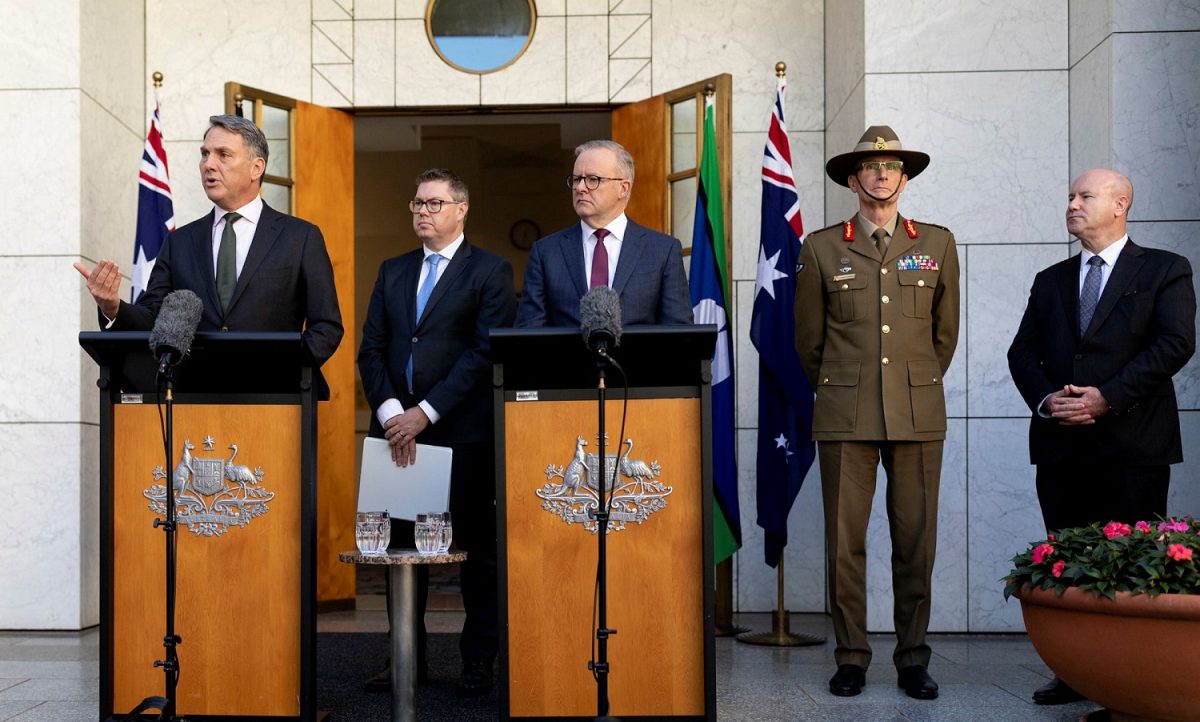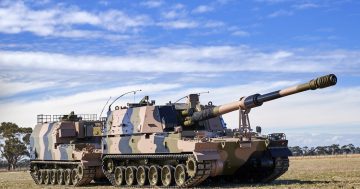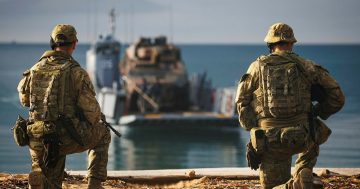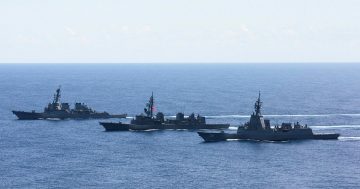
(L-R) Defence Minister and Deputy PM Richard Marles, Minister for Defence Industry Pat Conroy, PM Anthony Albanese, Chief of Defence Force General Angus Campbell, and Defence Secretary Greg Moriarty at the release of the DSR. Photo: ADF.
After all the hype of the past seven or eight months since it was initiated, there were very few surprises in the Defence Strategic Review (DSR).
All of the major capability ‘hardware’ announcements – of which there were not many – had either previously been identified in the 2020 Defence Strategic Update and Force Structure Plan, had been leaked, were more or less expected, or were little more than tinkering around the edges by delaying or accelerating programs or decreasing or increasing numbers.
In a teaser released last Friday (21 April), the government criticised its predecessors for announcing several big-ticket items in previous plans without any provisions made for funding them.
It claimed that more than $42 billion in additional defence spending over the decade to 2032-33 had been announced, without the provision of any additional allocation in the budget.
It said that, because of this funding shortfall, “New capability requirements coupled with sustainment demand for existing capabilities and the need to address severe workforce pressures will require difficult decisions and trade-offs to manage the defence budget over the immediate period”.
Perhaps the most interesting item was the commitment to more long-range missile systems, and to conduct a review of the Royal Australian Navy’s force structure, which aims to report by the end of this year.
The DSR argues that the Navy’s current fleet of three large amphibious vessels, three air warfare destroyers, eight anti-submarine frigates, and about a dozen smaller offshore patrol vessels is more suited to operating with conventional submarines such as the Navy’s Collins class, but not necessarily with the planned nuclear-powered subs.
“With AUKUS as the centrepiece of Australia’s current defence planning, it’s no surprise that Defence is shifting its focus away from land-based hardware such as infantry fighting vehicles toward long-range missiles, which complement submarines and the operational requirements within the maritime domain more broadly,” Dr Bianca Baggiarini, a lecturer at the ANU’s Strategic and Defence Studies Centre, told Region.
“The move towards long-range weapons and associated systems means that land and air domains are likely to shift – organisationally and philosophically – towards deterrence thinking in their support for maritime approaches,” she added.
The DSR’s call to accelerate the acquisition of systems such as the M142 HIMARS rocket system is also all well and good, but it fails to take into account the depletion of US HIMARS rocket stocks in recent months through military aid to Ukraine and the need to replenish those stocks, and a growing list of Eastern European customers for the system.
In a similar vein, the DSR barely touches on the previous government’s plan – which was unilaterally supported by Labor – to establish an advanced guided weapons development and manufacturing capability in Australia.
While this is an admirable ambition, no one has yet explained how the multiple layers of bureaucratic and political minefields of US export controls will allow such a sovereign capability to be established.
A separate announcement by Mr Marles on 26 April provided a little more clarity on the issue by allocating $4.1 billion to the development of a sovereign missile manufacturing capability, but isn’t expected to result in “costed plans presented for Government consideration” until 2024.
A positive element of the DSR was the government’s commitment to integrating defence and foreign policy as a whole-of-government approach, emphasising the importance of ‘statecraft’ in helping to determine Australia’s future security through the “collective security of the Indo-Pacific”.
In her speech to the National Press Club on 17 April, Foreign Minister Senator Penny Wong emphasised that Australia’s strategic interests are shared with many other nations in our region.
By shaping the region through coordinated statecraft, Senator Wong said Australia will contribute to a regional balance of power that will result in peace. “Strategic competition is operating on several levels. Domains that we might prefer to separate – economic, diplomatic, strategic, military – are all interwoven, and all framed by an intense contest of narratives.”
Almost as if in lockstep with Senator Wong, the DSR states: “National Defence must be anchored in a broader national strategy. This strategy should harness all elements of national power to protect Australia’s strategic interests, and contribute to the maintenance of a regional balance of power in the Indo-Pacific that is favourable to our interests.”
It recommends that “the Department of Foreign Affairs and Trade (DFAT) should be appropriately resourced to lead a nationally determined and strategically directed whole-of-government statecraft effort in the Indo-Pacific”.
Another positive is the DSR’s recognition of climate change as a threat to national security.
“Climate change is now a national security issue,” it says, adding that climate change “will increase the challenges for Australia and Defence, including increased humanitarian assistance and disaster relief tasks at home and abroad”.
But, for many reasons – some of which are understandable – the DSR is lacking in clarity. “It is less detailed, as many of the judgements and recommendations…are sensitive and classified,” the foreword written by DSR authors, former Labor Defence Minister Stephen Smith and former Chief of Defence Force Sir Angus Houston reads.
“The full classified Review is also strategic in nature, and will require significant effort and commitment to implement. Many of these challenges will require a whole-of-government and whole-of-nation effort.”
But that lack of clarity makes it difficult for the defence industry to plan, and for analysts and even defence writers to decipher its intent. One could even argue the lack of transparency of its strategic intent is exactly what Australia has accused China of doing in its own massive military build-up.
Referring to the delays to some programs caused by the DSR, Sarah Pavillard, founder and CEO of Canberra-based defence services firm ADROITA, said: “The risk for government and defence is that dual-use businesses, whether tech, services or manufacturing, pick up their capability and take it elsewhere, because ‘hurry up and wait’ does not make for a commercially viable business model, nor does tendering and expending resources to offer work that is subsequently withdrawn from the market, which has also been a persistent problem over the last 12 months.
“Urgency vs sovereign capability is not a zero-sum game, but industry won’t wait indefinitely either.”





















